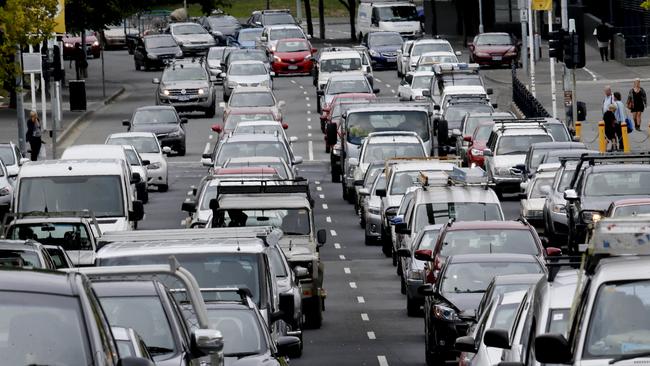Hobart traffic: The 2012 Hobart tunnel study which reveals why it can’t be done
John Livermore says Hobart is suffering from a congestion of traffic studies and reveals why a tunnel has already been ruled out.
Opinion
Don't miss out on the headlines from Opinion. Followed categories will be added to My News.
The State Government announcement that it is hiring GHD consultants for $750,000 to investigate the suitability of a western bypass of the CBD and related tunnelling repeats an exercise GHD undertook in 2012 for the Hobart City Council commissioned by the then Department of Infrastructure and Energy (DIER).
The 2012 GHD Report included an analysis for a tunnel with a link from Davey St and Macquarie St to a bypass linking the Southern Outlet to the Brooker Highway. The report concluded that by 2031 there would only be 1180 vehicles per afternoon and 1000 per morning in a tunnel. Additionally, only 14 per cent of the traffic on the main feeder routes (essentially Davey St and Macquarie St) were through-traffic as distinct from CBD-bound.
TALKING POINT: DON’T DIG US INTO A COSTLY HOLE
The DIER “Congestion in Greater Hobart: Response to Issues” report in 2011 made critical comment on a similar proposal made previously. Tunnels and bypasses, it said, were “vastly out of proportion to the traffic issues and reflects an infrastructure focus rather than a network or system wide perspective to address traffic issues”. The cost of building the tunnel (stage one from the Southern Outlet to the Brooker Highway) would be about $1 billion.
A 2008 traffic survey on Macquarie St and Davey St also indicated a large proportion of traffic there was not through-traffic but was Hobart CBD-bound. The proposed tunnel was only likely to remove 15 per cent of the Macquarie-Davey traffic during the morning peak and 14 per cent in the evening.
TALKING POINT: ONLY TUNNELS WILL HOBART’S TRAFFIC-JAM WOES
DIER concluded that building a tunnel or a bypass was unlikely to solve traffic issues on Macquarie St and Davey St because most traffic was not through traffic.

With the Brooker and Tasman Highway experiencing higher traffic volumes than Macquarie St and Davey St, the proposed tunnel or a bypass around the CBD did not target roads which had higher volumes or experienced greater delays. It was also noted that a tunnel would cause localised traffic congestion at either end, as traffic would be forced onto higher volume roads such as the Brooker and Tasman Highways.
The report raised concern that either a tunnel or bypass would be likely to have an impact on Hobart’s many heritage buildings and as a result of vibration and disturbance caused by drilling for the construction. An elevated freeway would also create a significant visual impact against the backdrop of Hobart CBD and the foothills of Mt Wellington, the lower slopes of which would also be affected by a bypass from McRobies Gully to South Hobart.
DIER also pointed out that tunnels require high traffic volumes to recoup costs.
It follows that a western bypass is not justified.
Meanwhile, a further investigation bankrolled by the State Government under the Hobart City Deal plan will result in yet another consultant’s investigation of the Hobart-Brighton rail link for commuter traffic. This, according to a Mercury correspondent, makes number 11 in the light rail saga.
These reports began under then premier David Bartlett’s Labor government in 2005, when Nick McKim became minister for sustainable transport. With his credentials it might have been supposed a light rail plan for action would emerge. However, the ACIL consultants took the Metro passenger numbers supplied by DIER and did no market research on potential passengers for light rail. The study omitted the effect of future housing development along the line of rail. The light rail proposal was ditched as non-viable.
In 2013 the Standing Committee of the Legislative Council on Sustainable Public Transport was highly critical of the whole process, judging that it did not take into account the socio-economic effect, tourism, health, land use planning and other positive community benefits a light rail service could bring to Hobart over the long term.
In remarkable U-turn last year the then minister for infrastructure Rene Hidding gave the green light for light rail from Mawson Place to Bridgewater, subject to yet another study.
David Bartlett hailed the Labor government decision to reduce CBD freight congestion and boost the viability of the Bridgewater Transport Interchange when Tasrail decided to cut the rail freight operation from Hobart port to Bridgewater. Tasrail estimated that as result of that closure 600 to l000 tonnes of freight per year would go on the Brooker Highway to Brighton. Tasrail may have made a commercial decision but doesn’t the resultant congestion speak volumes on all the past 20 years of delay, confused government policies or lack of them?
John Livermore is a fellow of the Chartered Institute of Logistics and Transport and a member of the Tasmanian Logistics Committee. The opinions expressed are not necessarily endorsed by either organisation.


